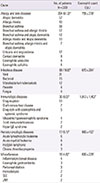Abstract
Purpose
Eosinophilia may be associated with various primary and reactive conditions. However, studies on the cause and incidence of eosinophilia in Korean children are rare. This study aimed to evaluate the cause and incidence of eosinophilia in patients at a single university hospital.
Methods
We studied 8,285 pediatric patients under the age of 18 years who had eosinophilia at Pusan National University Hospital. Premature and newborn infants were excluded. Eosinophilia was defined as an absolute eosinophil count greater than 450/µL. Eosinophilia was categorized as mild (450-1,500/µL), moderate (1,500-5,000/µL), and severe (>5,000/µL). The underlying conditions of eosinophilia were retrospectively investigated.
Results
Of 8,285 patients who had a hematology profile, 497 (5.9%) were found to have eosinophilia. Of patients with eosinophilia, 333 patients (67.0%) had identifiable and possible causes. The major causes of eosinophilia were allergic diseases (61.3%), infectious diseases (19.8%), immunologic diseases (9.0%) and hemato-oncologic disease (5.1%). Immunological disease such as Idiopathic hypereosinophilic syndrome, drug induced hypersensitivity syndrome and Graft-versus-host disease was the common condition with moderate to severe eosinophilia in which eosinophil count in peripheral blood was more than 1,500/µL.
Figures and Tables
References
1. Kim DW, Shin MG, Yun HK, Kim SH, Shin JH, Suh SP, et al. Incidence and causes of hypereosinophilia (corrected) in the patients of a University Hospital. Korean J Lab Med. 2009; 29:185–193.

2. Choi DC. Eosinophilia. Korean J Asthma Allergy Clin Immunol. 2011; 31:237–245.
3. Tefferi A, Patnaik MM, Pardanani A. Eosinophilia: secondary, clonal and idiopathic. Br J Haematol. 2006; 133:468–492.

4. Choi DC. Eosinophilic lung diseases: general concept. Korean J Allergy. 1997; 17:417–437.
5. Park CS, Kim TB, Cho YS, Moon HB. Diagnosis and treatment of Eosinophilia: a guideline for Korean patients. Korean J Asthma Allergy Clin Immunol. 2006; 26:186–197.
6. Roufosse F, Weller PF. Practical approach to the patient with hypereosinophilia. J Allergy Clin Immunol. 2010; 126:39–44.

7. Brito-Babapulle F. The eosinophilias, including the idiopathic hypereosinophilic syndrome. Br J Haematol. 2003; 121:203–223.

8. Kliegman RM, Stanton BF, St. Geme JW III, Schor NF, Behrman RE. Nelson textbook of pediatrics. 19th ed. Philadelphia: Elsevier/Saunders;2011. p. 766.
9. Tefferi A. Blood eosinophilia: a new paradigm in disease classification, diagnosis, and treatment. Mayo Clin Proc. 2005; 80:75–83.

10. Chung JP, Nam DK, Lee SJ, Lee EK, Hahn JS, Ko YW. A clinical study on eosinophilia; with a report of 5 cases of hypersoinophilic syndrome. Korean J Hematol. 1988; 23:127–137.
11. Shin KS, Choi YM, Chae SA, Hyung SM. A clinical study of cause of Eosinophilia. Chungbuk Med J. 1996; 6:105–114.
12. Wardlaw A. Eosinophils and their disorders. In : Lichtman M, Beutler E, Kaushansky K, Kipps T, Seligsohn U, Prchal J, editors. Williams hematology. 7th ed. New York, NY: Mc Graw-Hill;2006. p. 863–878.
13. Chusid MJ, Dale DC, West BC, Wolff SM. The hypereosinophilic syndrome: analysis of fourteen cases with review of the literature. Medicine (Baltimore). 1975; 54:1–27.
14. Kim MK. Biology of Eosinophil. Korean J Allergy. 1997; 1:409–416.
15. Kliegman RM, Stanton BF, St. Geme JW III, Schor NF, Behrman RE. Nelson textbook of pediatrics. 19th ed. Philadelphia: Elsevier/Saunders;2011. p. 740.
16. Shrestha S, Dongol SS, Shrestha NC, Shrestha RP. Clinical and laboratory profile of children with eosinophilia at Dhulikhel Hospital. Kathmandu Univ Med J (KUMJ). 2012; 10:58–62.

17. Singh V, Gomez VV, Swamy SG, Vikas B. Approach to a case of Eosinophilia. Ind J Aerospace Med. 2009; 53:58–64.




 PDF
PDF ePub
ePub Citation
Citation Print
Print




 XML Download
XML Download